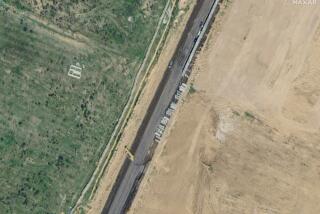NEWS AND BRIEFS : Egypt May Put Wall Around Pyramids, Sphinx
- Share via
Because too many people want to see the 5,000-year-old Pyramids and the Sphinx, Egyptian officials are considering building a wall around the ancient monuments.
Not to keep the tourists out, but rather to help save the structures for future generations to enjoy.
In the last few years, a rising water table in the Nile Valley, pollution and the spread of settlements have threatened the monuments.
A wall--as unobtrusive as possible and preferably built with local materials--would be built around them to control visitors and limit encroachment from nearby Nazlet el-Semman, a village whose main industry is catering to tourists.
A network of asphalt roads crisscrossing the plateau on which the monuments stand would be removed and replaced with tracks of stabilized sand. Motor traffic would be virtually banned.
All modern buildings within the wall would be razed, including a museum housing an ancient boat interred beside the Pyramid of Cheops and unearthed several years ago.
If approved by the Egyptian government, the wall is expected to take 1 1/2 years to complete. Whether it will stand for 5,000 is another matter.
More than a pinch: According to the latest edition of “Ford’s Freighter Travel Guide,” which apparently keeps track of this sort of thing, if all the salt in all the world’s oceans were crystallized, there would be enough to cover the Earth with a layer 45 feet high.
Statistics: The U.S. travel and tourism industry generates more revenue from foreign dollars than that generated from exports of automobiles, agricultural goods or chemical products.
Visitors to the United States this year will spend an estimated $48 billion, according to Rockwell A. Schnabel, the Commerce Department’s undersecretary for travel and tourism.
The travel-tourism industry generates revenues of about $1 billion a day, he said, adding that about 41 million foreigners will visit the United States this year.
In 1989, travel and tourism revenue reached a surplus for the first time, meaning that foreigners spent more in this country than U.S. residents spent overseas.
There’s no catch: If you happen to be in Vermont on Saturday, June 9, and want to drop a line into the water, feel free to do so. That’s the state’s “free fishing day,” when no license is required.
Staying out of Africa: Tourism overtook coffee and tea exports as Kenya’s top foreign exchange earner two years ago, but a decline in the number of visitors to the East African country has officials there worried.
“The importance of the (tourist) industry to the economy cannot be overemphasized,” vice president and finance minister George Saitoti told delegates to a national tourism seminar in Nairobi earlier this month.
Last summer, the United States advised citizens against traveling to Kenya after two Americans were killed in an attack on a tourist bus. It has not rescinded the advice, despite high-level appeals. Nor is it likely to, diplomats said, until Kenya offers proof of a reduction in crimes against tourists.
Kenya’s Indian Ocean coast, meanwhile, has lost European tourists after a series of health scares involving cerebral malaria, AIDS and even cholera.
Rail lines: That silver-and-blue flash you see streaking across the French countryside could well become a familiar sight before too long.
French railways expects to have its high-speed Train a Grande Vitesse (TGV) operating on at least three routes: from Paris to Bordeaux, Paris to Brussels and, most intriguing of all, Paris to London via the train tunnel being built under the English Channel.
The TGV recently set a world speed record for a train by clocking 320 m.p.h. during a test run.
The French have also sold the TGV to the Spanish National Railroads, which plans to use it on runs between Madrid and Seville.
Havana dreams: Cuba is hoping to offset an economic crisis by encouraging foreign investors to develop resort hotels that will lure the tourist dollar (or mark or yen or pound or whatever).
The newly inaugurated Sol Palmeras Hotel in Varadero, 60 miles from Havana, is the first of eight beach resort hotels to be built with private foreign investment and government money in the cities of Varadero, Santiago de Cuba and Havana.
Spanish, Finnish and Soviet investors are working with Cubanacan, the Cuban government tourism developer, to build the hotels.
Two-thousand more hotel rooms are expected to be ready by the end of the year. Most of them will be in four-star hotels.
Quick fact: Hungary, which has a population of about 10 million, attracted 14.5 million tourists in 1989, including a 27% increase from 1988 in the number of visitors from the United States.
Olympian effort: In an effort to persuade the 90-member International Olympic Committee to award Athens the Summer Olympics in 1996, Greek officials have drawn up detailed plans to rebuild much of the city.
Among the major projects are a new international airport costing $220 million, two underground railway lines costing $1 billion and the completion of two main roads costing $750 million.
Skeptics note that such plans have been around for years.
The IOC meets in Tokyo in September to choose the 1996 host city. Other candidates are Atlanta, Toronto, Belgrade, Melbourne and Manchester, England.
Quick facts: The American Society of Travel Agents would like you to know that:
--A total of 38.5 million foreign visitors came to the United States in 1989, or an average of 73 per second.
--The year before, foreign visitors spent $56,000 per minute in the United States.
--The federal government receives more in tax revenues from foreign visitors in four days than it spends on the U.S. Travel and Tourism Administration in one year.
More to Read
Sign up for Essential California
The most important California stories and recommendations in your inbox every morning.
You may occasionally receive promotional content from the Los Angeles Times.













